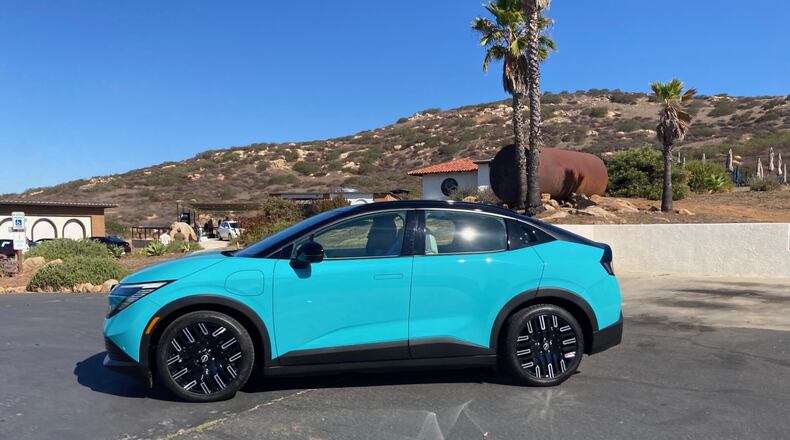It’s no secret that Nissan has had its share of difficulties of late, from a failed merger with rival Honda to a shake-up in the CEO’s office, all amid a stressful climate for automakers.
Like your otherwise-talented friend going through a rough patch, Nissan needs a win. The all-new Leaf just might be it.
Lest we forget, the Nissan Leaf was the first modern mainstream electric vehicle, debuting in 2011 — a year before the first Tesla Model S. That original Leaf was a small, awkward-looking hatchback with just 73 miles of range. A second generation arrived in 2018 with a cleaner look and up to 212 miles as updates rolled in. It made sense as a commuter, but it was hard to get excited about.
Credit: Courtesy of Matt Degen
Credit: Courtesy of Matt Degen
The OG EV grows up
Now comes the 2026 Leaf, and this one is different. For its third generation, it moves from hatchback to more of an SUV. Nissan calls it a crossover, and we won’t argue, even if it’s still front-wheel drive only and not all-wheel drive like the larger Ariya EV. Body style labels aside, it looks great with good proportions, and its slightly shorter length makes it a breeze to park.
Ease first, specs second
When it launches later this fall, every Leaf trim uses the same 75-kWh powertrain, making 214 horsepower and 262 pound-feet of torque. If you’re new to EVs, that number may not wow you, but electric power is instant — think light switch, not dimmer. The Leaf steps off the line briskly and settles into a calm, quiet groove. It won’t outmuscle bigger, pricier EVs, but compared with direct rivals like the Hyundai Kona EV and Kia Niro EV, it measures up.
More important for shoppers: range. The base S+ headlines at 303 miles. The mid-level SV+ is rated at 288 miles, and the top Platinum+ at 259. That’s enough for most weekly routines with some to spare. There are two charging ports: NACS (for DC fast charging at Tesla Superchargers) and a J1772 port on the other side for Level 2 at home or around town.
On the road, the Leaf is notably quiet — even by EV standards. There’s no full “one-pedal” mode that will bring you to a stop, but you can dial up brake regeneration with steering-wheel paddles and an e-step button, which lets you slow the car with minimal pedal work. Steering is light, the flat-bottom wheel feels good in your hands, and Nissan’s Zero Gravity seats keep things comfortable.
Value that’s easy to understand
Here’s the core of the Leaf’s pitch: price and simplicity. The S+ starts at $31,485, including a $1,495 destination fee. That makes it the least-expensive new EV on sale in the U.S., undercutting the Chevrolet Equinox EV by a few thousand dollars. The value story gets better when you note that the base model delivers the best range of the lineup.
There’s also a fun bit of perspective: 15 years after the original, this all-new Leaf starts below that first car’s $32,780 entry point — and matches the second gen’s 2018 starting price. Look, Ma: no inflation.
Nissan expects the SV+ to be the volume seller at $35,725. Along with its 288-mile range, it brings dual 14.3-inch displays, leatherette upholstery, 18-inch wheels, heated seats and a wireless phone charger. The $40,485 Platinum+ adds a hands-free power liftgate, vehicle-to-load capability (handy for powering tools or a campsite), Bose audio and a panoramic roof that can dim in sections. Nissan also plans a lower-priced variant with a smaller battery down the road.
For households and fleets watching running costs, the Leaf should pencil out. Electricity is typically cheaper than gasoline on a per-mile basis, maintenance is lighter, and the ability to use both common charging standards reduces hassle.
What it is — and isn’t
This is a subcompact EV wearing SUV clothes. The back seat is tighter than in larger crossovers, and there’s no frunk. But the hatch area is useful, opening to 55.5 cubic feet with the rear seats folded. Daily life with the Leaf is refreshingly uncomplicated: Get in, tap the drive selector, and go. No studying menus before enjoying the silence.
Shoppers should also be clear about the boundaries. There’s no AWD option at launch. And if you’re set on a true one-pedal driving mode, the Leaf stops just short. Those omissions help keep the price and efficiency in check.
The business angle
Nissan doesn’t need the Leaf to dominate every EV chart. It needs a credible, affordable entry that gets more people off the fence and into an electric car. The Leaf’s proposition is straightforward: familiar brand, approachable price, enough range and an ownership experience that won’t require disruption of routine. While some EVs chase luxury or ludicrous acceleration, the Leaf aims for the middle of Main Street — and that’s smart business.
Bottom line
After a day in the new 2026 Nissan Leaf, I came away impressed by how easy it is to live with. The original Leaf helped kick-start EVs. A decade and a half later, the formula has matured: Keep it simple, comfortable and affordable. For buyers who care as much about budgets as batteries, the Leaf’s value is hard to beat — and it might be the quiet win Nissan needs.
Matt Degen is a senior editor with Kelley Blue Book and Autotrader. He’s driven and reviewed practically every car model made in the past 15 years, all with the goal of helping shoppers find the right one for them.
The Steering Column is a weekly consumer auto column from Cox Automotive. Cox Automotive and The Atlanta Journal-Constitution are owned by parent company, Atlanta-based Cox Enterprises.
About the Author
Keep Reading
The Latest
Featured




